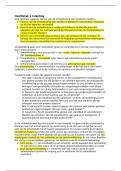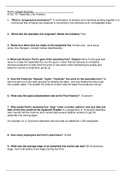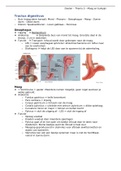OMICS-hoorcolleges deeltoets 2
Integrative OMICS - Guikema
Methodological reductionism: Attempt to explain systems in terms of their individual parts and their
interactions.
Je haalt een moeilijk organisme uit elkaar en focust op 1 punt om het te verduidelijken
Systems Biology: Organisms viewed as an integrated and interacting network of genes, proteins and
biochemical reactions. Instead of analyzing individual components (reductionism) or aspects of the
organism, systems biology focuses on all the components and the interactions among them, all as
part of one system.
Hoe gaan die systemen met elkaar om?
Systems Biology depends on reductionistic research.
Systems Biology needs the details of inventories for reconstructions of systems.
We kunnen alleen maar hypotheses ontkrachten, en
niet bevestigen
Inductie: je hebt data en deze pas je toe op de nieuwe situatie, begint met een patroon. (correlatie,
geen causaliteit)
Deductie: je brengt feiten samen
Traditionele wetenschappelijke methode: hypothesis-gebaseerde deductie
2de dimensie van wetenschappelijke methode: data-mining inspired induciotn
Instead of hypothesizing and testing whether gene X is upregulated under altered condition,
which of the genes in up- or down-regulated? à Omics approach: Elevate data to reveal new
insights by themselves. Oblivious to researcher’s preconceived notions! Uses inductive
reasoning.
Allochtone redenering: outside one’s comfort zone
Soms heb je een andere taal nodig (onze taal is biologie) om iets te kunnen snappen
Important ingredients:
1. Simplification and abstraction of the biological system. (risky!)
2. Correspondence rules that translate biological components and processes into mathematical
language.
• Biological system ‘transformed’ into pure mathematical contruct, results of analysis are
strictly mathematical.
• Correspondence rules move results back into realm of Biology.
• Parameters can be experimentally measured or fitted (which comes at a cost..).
• Overfitting: More parameters than justified by data. (Noise
is ‘interpreted’ as structure, violates Occam’s razor..)
• Underfitting: Some parameters are missing..
1
,Vector space of scientific methods
Generic recommendations
1. Start with big data
2. Determine associations and correlations
3. Mathematical realm: filter out spurious (‘fake’) correlations in high-throughput
4. Perform iteratively (go back to 1...)
5. Surviving associations are good candidates for further experimental/computational testing.
WET LAB PERSPECTIVE: ULTIMATELY ”SURVIVING” HYPOTHESES MUST STILL BE TESTED FOR
VALIDITY THROUGH CONVENTIONAL EXPERIMENTS!!
2
,Data analysis and experimental design – Johan Westerhuis
Begrippen snappen en voorbeeld kunnen geven wanneer je ze gebruikt
Experimental design and data collection.
• Frame a biological question.
o Which transcripts / metabolites are diferent between healthy and metabolic
• disease patients
o Write question as hypothesis:
• H0: metabolites healthy = metabolites patient
• H1: metabolites healthy ≠ metabolites patient
o Define statistical test and measurement platform
• Design factor (controlled)/ observational factor (not controlled)
o Diferent treatment (levels) / Select from predefined groups
• Identify noise factors (confounding).
o Male / female, pregnancy, other diseases, medication, bmi, ...
o Experimental variation, multiple arrays,
• Design the experiment.
o Factors, Replicates, Randomization, Blocking
• Execute the experiment.
o Collect samples, Measure response
Experimental Design
Type of questions
• 1) Detection of responsive features (genes, proteins or metabolites) under controlled
experimental conditions (perturbation study / causal relationships)
o H0: Gene unperturbed = gene perturbed
• 2) Detection of biomarkers (Diference between patient and control, observational)
o H0: Gene patient = gene control
• 3) Identification of regulatory or mechanistic relationships between features.
o No relationship, vs relationship (linear, exponential, ...)
o Associations, correlations
o More explorative analysis
Noise factors
• Noise (confounding) factors can disturb correct estimation of the efect of the experimental
factor.
o Temperature, Time (summer/winter), Gender, Age,
• Some of these noise factors can be controlled in the experiment
o Only take males, Keep temperature constant,..
• Others cannot be controlled (e.g. time, biological variation) and have to be taken into
account when designing the experiment by
o Randomization
o Blocking
o Replication
Experimental design: Randomization
• To reduce influence of uninteresting factors.
• Randomize individuals over groups: treatment, control
• Randomize experiments over time (so time cannot be causing an efect)
• Randomize samples over batches / slides: not all controls in one batch and treated samples
on another.
3
, Experimental Design: Blocking
• Make blocks of experiments if
o Not all experiments can be done on 1 day
• Fix samples over days (each day equal number of cases and controls)
• Randomize samples (case / control) within days.
• Ignore efect of day
o Measured levels could be diferent for specific groups
• Fix treated / controls equal over groups
• Randomize treatment / control within group
• Ignore efect of groups
• With blocking we STATE that block efect (diference between blocks) is NOT RELEVANT.
• Fix over blocks, randomize within blocks
Experimental Design: Replication
• Replication: repeat analysis to decrease biological variation and/or analytical variation
o Measure more individuals per group
o Repeat treatment for an individual
o Measure sample multiple times
• The mean is better estimated when more repeats
• are performed.
• Measured efect = true efect + biological variation + analytical variation
Samenvatting tot nu toe:
• Repeatability is the degree of agreement between measurements conducted on the same
sample in the same location by the same people
• Reproducibility is the degree of agreement between measurements conducted on replicate
samples in diferent locations by diferent people
• Analytical variation:
o Repeatability, Reproducibility
o Bias (systematic deviation from true value)
• Biological variation:
o variation between individuals in same group: ofset and efect-size
o within individuals, between biological experiments
• Measured efect = true efect + biological variation + analytical variation
2. DATA PREPROCESSING AND QUALITY CONTROL
• Disturbances of a whole sample.
o Amount of sample is diferent
o Some samples are more diluted than others
o Order of measuring afects measurement
• Disturbance of single feature in a sample
o Alignment problems due to aging of chromatographic column.
4
Integrative OMICS - Guikema
Methodological reductionism: Attempt to explain systems in terms of their individual parts and their
interactions.
Je haalt een moeilijk organisme uit elkaar en focust op 1 punt om het te verduidelijken
Systems Biology: Organisms viewed as an integrated and interacting network of genes, proteins and
biochemical reactions. Instead of analyzing individual components (reductionism) or aspects of the
organism, systems biology focuses on all the components and the interactions among them, all as
part of one system.
Hoe gaan die systemen met elkaar om?
Systems Biology depends on reductionistic research.
Systems Biology needs the details of inventories for reconstructions of systems.
We kunnen alleen maar hypotheses ontkrachten, en
niet bevestigen
Inductie: je hebt data en deze pas je toe op de nieuwe situatie, begint met een patroon. (correlatie,
geen causaliteit)
Deductie: je brengt feiten samen
Traditionele wetenschappelijke methode: hypothesis-gebaseerde deductie
2de dimensie van wetenschappelijke methode: data-mining inspired induciotn
Instead of hypothesizing and testing whether gene X is upregulated under altered condition,
which of the genes in up- or down-regulated? à Omics approach: Elevate data to reveal new
insights by themselves. Oblivious to researcher’s preconceived notions! Uses inductive
reasoning.
Allochtone redenering: outside one’s comfort zone
Soms heb je een andere taal nodig (onze taal is biologie) om iets te kunnen snappen
Important ingredients:
1. Simplification and abstraction of the biological system. (risky!)
2. Correspondence rules that translate biological components and processes into mathematical
language.
• Biological system ‘transformed’ into pure mathematical contruct, results of analysis are
strictly mathematical.
• Correspondence rules move results back into realm of Biology.
• Parameters can be experimentally measured or fitted (which comes at a cost..).
• Overfitting: More parameters than justified by data. (Noise
is ‘interpreted’ as structure, violates Occam’s razor..)
• Underfitting: Some parameters are missing..
1
,Vector space of scientific methods
Generic recommendations
1. Start with big data
2. Determine associations and correlations
3. Mathematical realm: filter out spurious (‘fake’) correlations in high-throughput
4. Perform iteratively (go back to 1...)
5. Surviving associations are good candidates for further experimental/computational testing.
WET LAB PERSPECTIVE: ULTIMATELY ”SURVIVING” HYPOTHESES MUST STILL BE TESTED FOR
VALIDITY THROUGH CONVENTIONAL EXPERIMENTS!!
2
,Data analysis and experimental design – Johan Westerhuis
Begrippen snappen en voorbeeld kunnen geven wanneer je ze gebruikt
Experimental design and data collection.
• Frame a biological question.
o Which transcripts / metabolites are diferent between healthy and metabolic
• disease patients
o Write question as hypothesis:
• H0: metabolites healthy = metabolites patient
• H1: metabolites healthy ≠ metabolites patient
o Define statistical test and measurement platform
• Design factor (controlled)/ observational factor (not controlled)
o Diferent treatment (levels) / Select from predefined groups
• Identify noise factors (confounding).
o Male / female, pregnancy, other diseases, medication, bmi, ...
o Experimental variation, multiple arrays,
• Design the experiment.
o Factors, Replicates, Randomization, Blocking
• Execute the experiment.
o Collect samples, Measure response
Experimental Design
Type of questions
• 1) Detection of responsive features (genes, proteins or metabolites) under controlled
experimental conditions (perturbation study / causal relationships)
o H0: Gene unperturbed = gene perturbed
• 2) Detection of biomarkers (Diference between patient and control, observational)
o H0: Gene patient = gene control
• 3) Identification of regulatory or mechanistic relationships between features.
o No relationship, vs relationship (linear, exponential, ...)
o Associations, correlations
o More explorative analysis
Noise factors
• Noise (confounding) factors can disturb correct estimation of the efect of the experimental
factor.
o Temperature, Time (summer/winter), Gender, Age,
• Some of these noise factors can be controlled in the experiment
o Only take males, Keep temperature constant,..
• Others cannot be controlled (e.g. time, biological variation) and have to be taken into
account when designing the experiment by
o Randomization
o Blocking
o Replication
Experimental design: Randomization
• To reduce influence of uninteresting factors.
• Randomize individuals over groups: treatment, control
• Randomize experiments over time (so time cannot be causing an efect)
• Randomize samples over batches / slides: not all controls in one batch and treated samples
on another.
3
, Experimental Design: Blocking
• Make blocks of experiments if
o Not all experiments can be done on 1 day
• Fix samples over days (each day equal number of cases and controls)
• Randomize samples (case / control) within days.
• Ignore efect of day
o Measured levels could be diferent for specific groups
• Fix treated / controls equal over groups
• Randomize treatment / control within group
• Ignore efect of groups
• With blocking we STATE that block efect (diference between blocks) is NOT RELEVANT.
• Fix over blocks, randomize within blocks
Experimental Design: Replication
• Replication: repeat analysis to decrease biological variation and/or analytical variation
o Measure more individuals per group
o Repeat treatment for an individual
o Measure sample multiple times
• The mean is better estimated when more repeats
• are performed.
• Measured efect = true efect + biological variation + analytical variation
Samenvatting tot nu toe:
• Repeatability is the degree of agreement between measurements conducted on the same
sample in the same location by the same people
• Reproducibility is the degree of agreement between measurements conducted on replicate
samples in diferent locations by diferent people
• Analytical variation:
o Repeatability, Reproducibility
o Bias (systematic deviation from true value)
• Biological variation:
o variation between individuals in same group: ofset and efect-size
o within individuals, between biological experiments
• Measured efect = true efect + biological variation + analytical variation
2. DATA PREPROCESSING AND QUALITY CONTROL
• Disturbances of a whole sample.
o Amount of sample is diferent
o Some samples are more diluted than others
o Order of measuring afects measurement
• Disturbance of single feature in a sample
o Alignment problems due to aging of chromatographic column.
4










